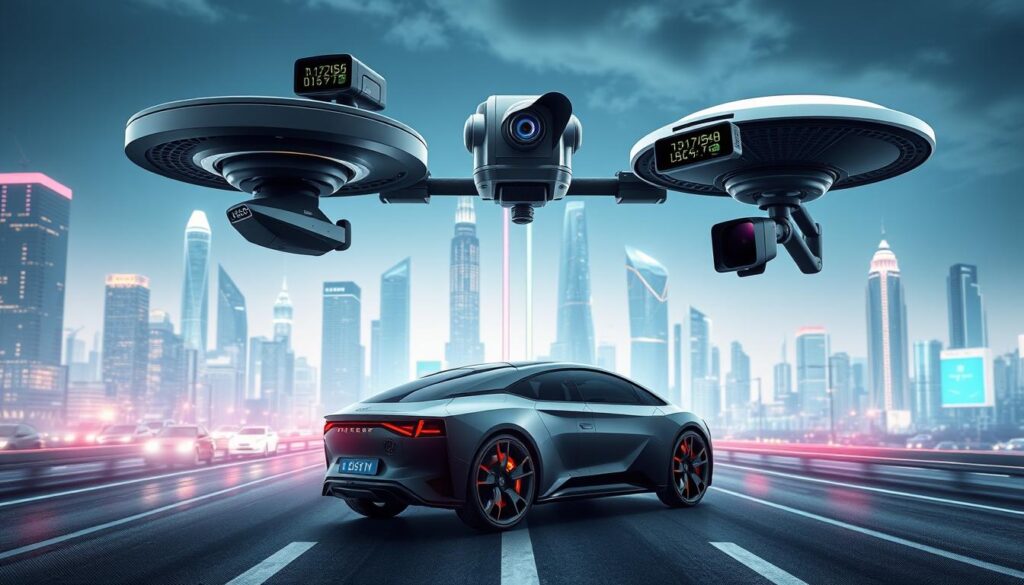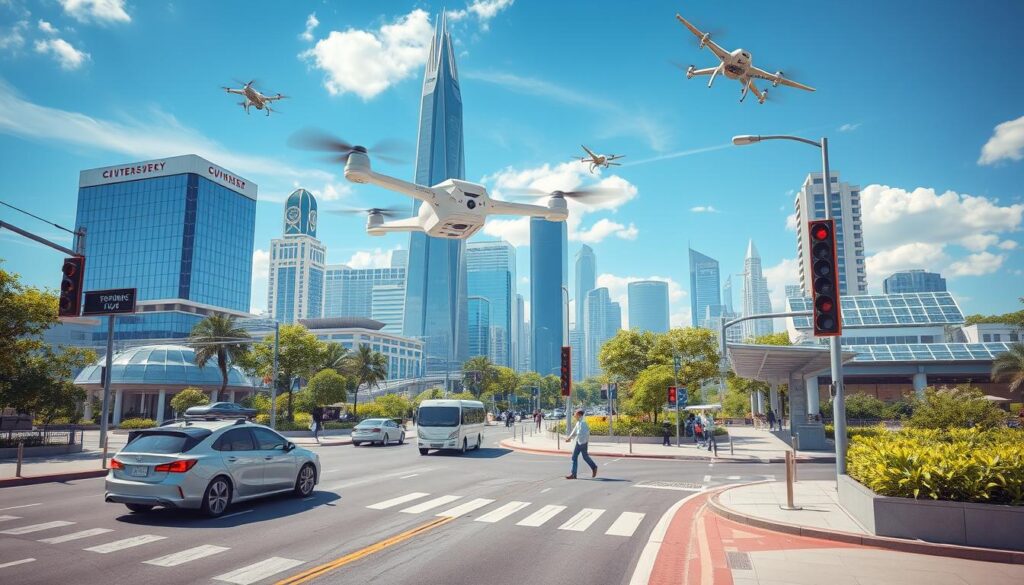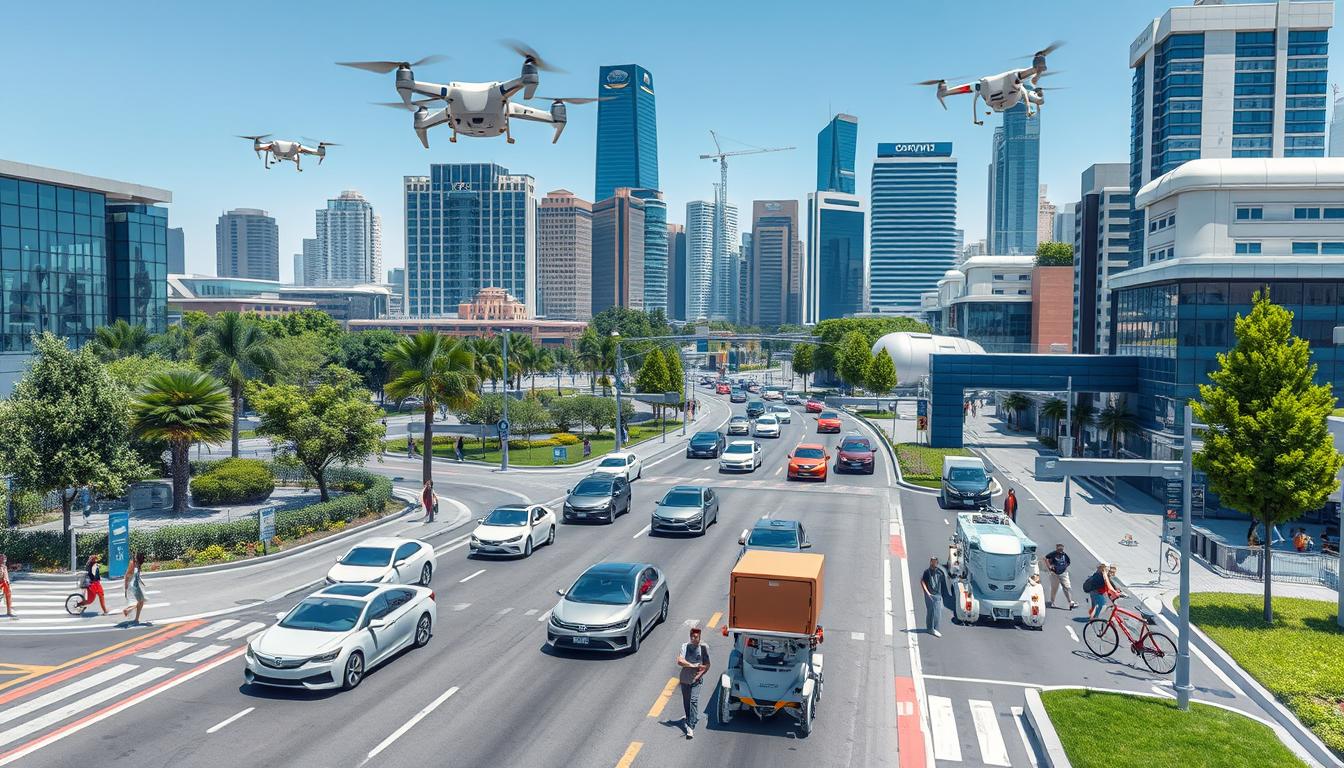“As an Amazon Associate I earn from qualifying purchases.” .
As I watch cars move through traffic, I think about the future. Soon, we might see cars driving themselves. The world of autonomous systems is changing fast, and it’s exciting.
These systems use artificial intelligence and robotics. They’re not just in movies anymore. They’re changing how we work and live, from driving cars to helping in healthcare.
The growth of autonomous systems is amazing. By 2024, the market will be over $65 billion. Business leaders are taking notice, with 86% expecting big changes.
We’re going to dive into how these systems work and their impact. From cars that drive themselves to robots in factories, the future looks bright.
Key Takeaways
- Autonomous systems market to surpass $65 billion by 2024
- 86% of IT leaders expect significant organizational changes
- Self-driving technology is transforming transportation
- AI and robotics are the core of autonomous systems
- Autonomous systems are revolutionizing multiple industries
- The field presents both opportunities and challenges
Understanding Autonomous Systems in Today’s World
Autonomous systems have changed many industries around the world. They work on their own, using sensors, AI, and data. This change is thanks to advances in Cognitive Computing and machine learning.
Definition and Key Characteristics
Autonomous systems can see their surroundings, make choices, and act on their own. The Society of Automotive Engineers (SAE) has five levels of autonomy. These range from Level 0 (no automation) to Level 5 (full automation).
Historical Context and Evolution
The idea of autonomous systems started in the 1960s with genetic algorithms. Neural networks and deep learning in the 1980s helped AI grow. Now, DARPA’s TIAMAT program works on making AI better for changing environments.
Current Examples in Various Industries
Autonomous systems are used in many fields:
- Transportation: Self-driving cars
- Manufacturing: Smart robotics
- Healthcare: Autonomous assistance
- Aerospace: Drones and aerial robotics
Places like Worcester Polytechnic Institute and the University of Manchester work with companies like Thales UK Research and Renault. They get help from the Royal Academy of Engineering and UK Research and Innovation (UKRI).
“The integration of self-evolving AI into autonomous systems offers advantages like adaptability to new environments, improved decision-making, and enhanced learning from experience.”
The Technology Behind Autonomous Systems
Autonomous systems use advanced tech to work well and safely. They have parts that help them see, decide, and act on their own.
Sensors and Data Collection
These systems have many sensors to learn about their world. LIDAR maps in 3D, radar spots objects, cameras see visually, and ultrasonic sensors check close by. Together, they understand their environment fully.

Algorithms and Decision-Making
The Autonomous Systems Lab (ASL) creates algorithms for decision-making. These algorithms use sensor data to find objects, plan routes, and guess what will happen next. For example, self-driving cars use deep learning to drive in cities.
Machine Learning and AI Integration
Machine Learning and Artificial Intelligence are key for these systems. They help them adjust to new situations and make smart choices with current data. Unmanned Vehicles, like those in the Indy Autonomous Challenge, use neural networks to speed through obstacles.
| Application | Technology Used | Benefits |
|---|---|---|
| Self-driving cars | Deep Reinforcement Learning | Efficient navigation in complex environments |
| UAV operations | Neural Networks | Practical training in simulated environments |
| Autonomous ships | AI-based control systems | Potential for improved nautical operations |
| Power system management | AI algorithms | Efficient energy distribution |
| Traffic light control | Machine Learning models | Optimized traffic flow and reduced congestion |
In 2024, Michigan State University’s team broke a record at the Indy Autonomous Challenge. They showed how AI and Machine Learning can make autonomous systems even better.
Applications of Autonomous Systems
Autonomous systems are changing many industries. They offer new ways to solve big problems. These smart machines are changing how we live, work, and interact with the world.
Autonomous Vehicles
Self-driving cars and taxis are leading the way in transportation. Companies are working on making our roads safer and more efficient. These cars use sensors and AI to handle tough traffic situations.
Drones and Aerial Robotics
Drones are getting more use for watching over areas, delivering things, and checking the environment. They help in security by watching over big areas with cameras. AI helps spot dangers quicker than people can.
Smart Robotics in Manufacturing
Robots are making factories work better. They help make things more efficiently and accurately. People are mostly okay with robots and AI, showing they’re welcome in our society.
Healthcare and Autonomous Assistance
Robots are making a big difference in healthcare. They help with surgeries and care for patients. This shows how autonomous systems can make things better in many fields.
“The integration of drones and AI technologies is transforming the security industry, resulting in improved efficiency, effectiveness, and cost reductions.”
As autonomous systems keep getting better, they will change many areas of life. They promise to make our lives better in ways we can’t yet imagine.
The Benefits of Autonomous Systems
Autonomous systems, powered by Artificial Intelligence and Smart Systems, are changing many industries. These advanced technologies offer big benefits to businesses and society.
Increased Efficiency and Productivity
Cognitive Computing makes autonomous systems better at optimizing processes and cutting down on mistakes. Self-driving cars help traffic flow better and reduce jams. Businesses can automate tasks that are repetitive, making them more efficient.
Autonomous AI looks at consumer data and gives personalized marketing tips. This helps marketing teams a lot.
Safety Enhancements
Autonomous vehicles use sensors like LiDAR and cameras to see everything around them. They can process data fast, which might lower road accidents and save lives. In healthcare, AI quickly looks at patient data, giving insights that humans can’t.
Cost-Effectiveness
Autonomous systems use resources better and lower labor costs. Self-driving delivery cars work all day, every day, saving time and money for logistics. In manufacturing, robots automate tasks, freeing up workers to do more important things.
| Benefit | Impact |
|---|---|
| Efficiency | Reduced traffic congestion, automated tasks |
| Safety | Fewer road accidents, improved healthcare insights |
| Cost Savings | Lower delivery costs, optimized resource use |

While the benefits are huge, businesses need to think about the costs and follow rules like Executive Order 14110 for safe AI use. As autonomous systems get better, they will change industries and make our lives better.
Challenges Facing Autonomous Systems
Artificial Intelligence and Robotics are making big strides. But, they face big challenges. These issues are in ethics, tech, and rules, making it hard to use self-driving tech everywhere.
Ethical Considerations
Self-driving cars bring up tough questions. What should they do in accidents? This problem isn’t just for cars but also for AI in healthcare and security.
Technical Limitations
Robotics and AI have many tech hurdles. Self-driving cars need to handle different roads, weather, and traffic. Researchers are working to solve these problems with better sensors and algorithms.
Regulatory Framework
The rules for self-driving cars and drones are changing. Governments are figuring out how to manage these new techs. They need clear rules for testing, using, and who’s responsible.
| Automation Level | Description | Human Involvement |
|---|---|---|
| Level 1 | Some automated functions | High |
| Level 2 | Driver assistance systems | Moderate |
| Level 3 | Conditional automation | Low |
| Level 4 | High automation | Minimal |
| Level 5 | Full automation | None |
As we move forward, solving these problems is key. It will help us use autonomous tech in many areas.
The Future of Autonomous Systems
The future of autonomous systems is exciting. Artificial Intelligence and Robotics are making Intelligent Automation more common in many areas.
Trends to Watch
AI algorithms are getting smarter in autonomous systems. This means they can make better decisions in tough situations. Self-driving cars are also becoming more common, marking a big step in car technology.
Potential Innovations
There’s a lot of room for new ideas in autonomous systems. Generative AI could change how we test self-driving cars. It lets engineers test systems in virtual worlds before they hit the road.
Impact on Job Markets
Autonomous systems will change the job market a lot. Some jobs might disappear, but new ones will appear. For example, the MATRIX Lab is training high school students in AI and robotics.
| Aspect | Impact |
|---|---|
| Job Creation | AI development, system maintenance, data analysis |
| Education | Increased focus on STEM fields, specialized robotics programs |
| Industry Transformation | Automation in manufacturing, self-driving vehicles in transportation |
As we look ahead, we must think about the ethics of autonomous systems. Issues like data privacy and AI bias are key to their future.
Key Industries Utilizing Autonomous Systems
Autonomous systems are changing many sectors, from transportation to farming. They make processes more efficient and safer. This is true across different industries.
Transportation and Logistics
Self-driving tech is changing how we move things. Unmanned vehicles are now used in logistics. Companies like Faction are making platforms for these vehicles.
Subskryb’s platform is changing how we own cars. It offers a new way to use vehicles.
Agriculture
Smart systems in farming are boosting productivity. Autonomous tractors and drones help monitor crops. AI techniques make farming more precise.
These tools help farmers make better decisions based on data.
Environmental Monitoring
Autonomous systems are key in environmental research. Unmanned vehicles collect data on wildlife and climate. This data is essential for protecting our ecosystems.
Retail and Commerce
Retail is also using autonomous systems. Sensei uses AI for retail solutions. Leav offers an automated checkout platform.
This improves the shopping experience and cuts down on static checkouts.
| Industry | Application | Benefits |
|---|---|---|
| Transportation | Self-driving vehicles | Improved safety, efficiency |
| Agriculture | Autonomous tractors, drones | Increased crop yields, resource management |
| Environmental | Data collection drones | Better climate research, wildlife tracking |
| Retail | Automated checkouts | Enhanced customer experience, cost reduction |
Autonomous systems are being used in many industries. They show how versatile they are in solving specific problems. They also make operations more efficient.
A Deep Dive into Autonomous Vehicles
Autonomous vehicles are changing how we travel with Self-Driving Technology. They use Artificial Intelligence and Robotics to move without a driver.
Types of Autonomous Vehicles
There are many types of self-driving cars, like trucks and public transport. They use sensors, AI, and learning to drive safely.
Key Players in the Market
The market for self-driving cars is very competitive. Big tech companies and car makers are spending a lot on this tech. Baidu and Alphabet are leading in new ideas, followed by GM, Ford, and Toyota. Nvidia and Qualcomm are making special chips for these cars.
| Company | Innovation Focus | Market Position |
|---|---|---|
| Baidu | AI and Self-Driving Technology | Leading |
| Alphabet (Waymo) | Full Autonomous Systems | Leading |
| GM | Electric and Autonomous Vehicles | Strong Contender |
| Nvidia | Specialized Chips | Emerging Leader |
Regulatory Challenges
The self-driving car industry faces big challenges. They need to set safety standards, figure out who’s liable, and make rules for testing and use. Without common labels, sharing data is hard.
But the benefits are huge. Self-driving cars could make roads safer and create a big new industry. As tech gets better, we might see these cars everywhere soon.
Autonomous Systems in Defense and Security
Unmanned Vehicles, Artificial Intelligence, and Robotics are changing military operations. The global market for military robotics and autonomous systems is growing fast. It’s expected to hit $27.5 billion by 2030, with a 13% annual growth rate.
Applications in Military Operations
Autonomous systems are changing how battles are managed. Israel uses the Harpy loitering munition to watch and disable radar targets for up to nine hours on its own. Turkey has the Kargu-2, which finds and tracks targets using computer vision.
Threats and Security Concerns
The rise of autonomous systems brings new security worries. Cyber threats are a big risk, including attacks that disrupt business and zero-day attacks. To fight these, five defense strategies have been developed:
- Automatically-generated multi-dimensional allow lists
- Automatically-embedded access control
- Automatically-embedded Control-Flow Integrity
- Enabling vendor-sourced updates
- Eliminating developer disruption
Future Developments
The future of autonomous systems in defense is about better decision-making and working together. On February 16, 2023, 47 countries backed a Political Declaration on using Artificial Intelligence and Autonomy responsibly. This shows how important ethics are in this field.
Autonomous, deterministic security is key for protecting against hacking. It can stop zero-day attacks without needing developers. This ensures strong defense for the changing world of military technology.
Conclusion: The Path Ahead for Autonomous Systems
The future of autonomous systems looks bright. Artificial Intelligence (AI) and Robotics are leading the way. They are changing industries like transportation and agriculture.
Summary of Key Insights
The Society of Automotive Engineers has outlined six levels of vehicle autonomy. This shows how we’re moving towards fully automated cars. Companies like Tesla and Waymo are using advanced AI and sensors to make this happen.
In farming, autonomous tractors are making crops grow better and faster. In construction and mining, these systems are making work safer and more efficient.
The Role of Public Policy and Research
As autonomous systems grow, public policy and research are key. We need to tackle issues like who’s responsible when something goes wrong. We also need to build trust with the public.
The industry must work with policymakers. Together, we can create safe and ethical rules for these technologies.
Final Thoughts on Integration and Acceptance
Getting autonomous systems widely accepted is a big challenge. Companies like Atlas Copco are showing the way with Intelligent Automation. Their solutions make production better and safer.
As these systems improve, they will likely become more popular. They could help prevent accidents, use resources better, and open up new ways of doing things.
FAQ
What are autonomous systems?
How do autonomous systems work?
What are the main applications of autonomous systems?
What are the benefits of autonomous systems?
What challenges do autonomous systems face?
How are autonomous systems changing the job market?
What is the future outlook for autonomous systems?
How are autonomous systems used in defense and security?
What are the levels of autonomy in vehicles?
How is public policy shaping the development of autonomous systems?
“As an Amazon Associate I earn from qualifying purchases.” .



